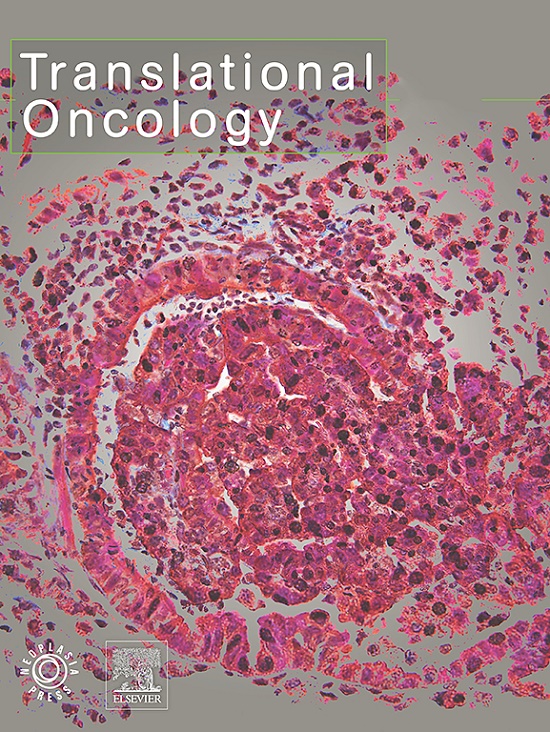Development and validation of a radiomic prediction model for TACC3 expression and prognosis in non-small cell lung cancer using contrast-enhanced CT imaging
IF 5
2区 医学
Q2 Medicine
引用次数: 0
Abstract
Backgrounds
Non-small cell lung cancer (NSCLC) prognosis remains poor despite treatment advances, and classical prognostic indicators often fall short in precision medicine. Transforming acidic coiled-coil protein-3 (TACC3) has been identified as a critical factor in tumor progression and immune infiltration across cancers, including NSCLC. Predicting TACC3 expression through radiomic features may provide valuable insights into tumor biology and aid clinical decision-making. However, its predictive value in NSCLC remains unexplored. Therefore, we aimed to construct and validate a radiomic model to predict TACC3 levels and prognosis in patients with NSCLC.
Materials and methods
Genomic data and contrast-enhanced computed tomography (CT) images were sourced from The Cancer Genome Atlas (TCGA), Gene Expression Omnibus (GEO) database, and The Cancer Imaging Archive (TCIA). A total of 320 cases of lung adenocarcinoma from TCGA and 122 cases of NSCLC from GEO were used for prognostic analysis. Sixty-three cases from TCIA and GEO were included for radiomics feature extraction and model development. The radiomics model was constructed using logistic regression (LR) and support vector machine (SVM) algorithms. We predicted TACC3 expression and evaluated its correlation with NSCLC prognosis using contrast-enhanced CT-based radiomics.
Results
TACC3 expression significantly influenced NSCLC prognosis. High TACC3 levels were associated with reduced overall survival, potentially mediated by immune microenvironment and tumor progression regulation. LR and SVM algorithms achieved AUC of 0.719 and 0.724, respectively, which remained at 0.701 and 0.717 after five-fold cross-validation.
Conclusion
Contrast-enhanced CT-based radiomics can non-invasively predict TACC3 expression and provide valuable prognostic information, contributing to personalized treatment strategies.
利用对比增强 CT 成像开发和验证非小细胞肺癌 TACC3 表达和预后的放射学预测模型
背景尽管治疗取得了进展,但非小细胞肺癌(NSCLC)的预后仍然很差,经典的预后指标在精准医疗中往往不尽如人意。转化酸性盘绕线圈蛋白-3(TACC3)已被确定为包括NSCLC在内的各种癌症的肿瘤进展和免疫浸润的关键因素。通过放射学特征预测 TACC3 的表达可为肿瘤生物学提供有价值的见解,并有助于临床决策。然而,它在 NSCLC 中的预测价值仍有待探索。材料与方法基因组数据和对比增强计算机断层扫描(CT)图像来自癌症基因组图谱(TCGA)、基因表达总库(GEO)数据库和癌症影像档案(TCIA)。共有 320 例来自 TCGA 的肺腺癌病例和 122 例来自 GEO 的 NSCLC 病例被用于预后分析。其中63例来自TCIA和GEO,用于放射组学特征提取和模型开发。利用逻辑回归(LR)和支持向量机(SVM)算法构建了放射组学模型。我们预测了TACC3的表达,并利用对比增强CT放射组学评估了其与NSCLC预后的相关性。TACC3的高水平与总生存率的降低有关,这可能是由免疫微环境和肿瘤进展调控介导的。LR算法和SVM算法的AUC分别为0.719和0.724,经过五倍交叉验证后仍分别为0.701和0.717。
本文章由计算机程序翻译,如有差异,请以英文原文为准。
求助全文
约1分钟内获得全文
求助全文
来源期刊

Translational Oncology
ONCOLOGY-
CiteScore
8.40
自引率
2.00%
发文量
314
审稿时长
54 days
期刊介绍:
Translational Oncology publishes the results of novel research investigations which bridge the laboratory and clinical settings including risk assessment, cellular and molecular characterization, prevention, detection, diagnosis and treatment of human cancers with the overall goal of improving the clinical care of oncology patients. Translational Oncology will publish laboratory studies of novel therapeutic interventions as well as clinical trials which evaluate new treatment paradigms for cancer. Peer reviewed manuscript types include Original Reports, Reviews and Editorials.
 求助内容:
求助内容: 应助结果提醒方式:
应助结果提醒方式:


